
The 40th anniversary of the historic Anangu Pitjantjatjara Yankunytjatjara (APY) Land Rights Act has been acknowledged during the longawaited Kulilaya Festival in Umuwa.



The 40th anniversary of the historic Anangu Pitjantjatjara Yankunytjatjara (APY) Land Rights Act has been acknowledged during the longawaited Kulilaya Festival in Umuwa.

A former opal miner, senior community leader, George Cooley, holds leadership positions across his home region of Coober Pedy and Umoona, where the sweeping landscape forms inspiration for his art.
Mr Cooley focuses on painting his Country, particularly the Kanku Breakaways, an important site 25km north of Coober Pedy, featuring spectacular hills and plains.
This year Mr Cooley’s work features at the Adelaide Biennial of Australian Art, the longest-standing survey of contemporary Australian art, between March 1-June 2 at the Art Gallery of South Australia (AGSA).
Compared to many of his contemporaries showcasing at the Biennial, George is a relative newcomer, having picked up a brush for the first time in 2021.
“The Country that I paint on is the escarpment where water eroded, came down off the tableland and eroded the area,” Mr Cooley said.
“It exposed a lot of the first, second and third layers of the sandstone and ochre Country there.”
Mr Cooley’s key artistic focus, the Kanku Breakaways, is a particular area of the Stuart range that he estimates runs for a couple hundred kilometres.
When opportunity recently came knocking, he decided to take his love of the area to a canvas, utilising networks provided by the APY Art Centre Collective.
“We’ve got a really good Aboriginal arts centre here in Adelaide formed by the APY Art Centre Collective, a group of communities that came together and formed in 2019 and asked if we were interested in joining them,” Mr Cooley said.
“Our people said yes because we are all family, they (APY) helped us from 2019 until recently where we’re just about to open our own art centre in Coober Pedy.”
In total George created four different artworks for AGSA’s 2024 Biennial, with one of the works featured prominently in the main gallery foyer.
“I delivered the skylines because it depicts the morning, evening and late twilight setting,” Mr Cooley said.
“If you’re blessed like I am, I wake up to it every day and if I’m on Country even better.”
Since the age of 16, Mr Cooley has been digging for opal in Coober Pedy’s famous reserves, with an “on and off” approach over the past few years.
To generate funds when the opal digs weren’t fruitful, he would work for Umoona community on a range of different maintenance projects.
“Somewhere along the line you run out of money and
then you’ve gotta pull up and get some fuel money and paper,” Mr Cooley said.
“So I spent time working for Umoona community, that sort of covered some of my costs, I’ve had a big hand in developing the community over the past 30-40 years.”
Mr Cooley is a passionate advocate for his Country and works to encourage people to visit his neck of the woods.
“Unless you come and see it you can’t sort of describe it…I don’t want to capture a pictureperfect painting I just want to capture a natural setting as it is in that environment.”
The 18th Biennial survey at AGSA opened March 1 and will run until June.
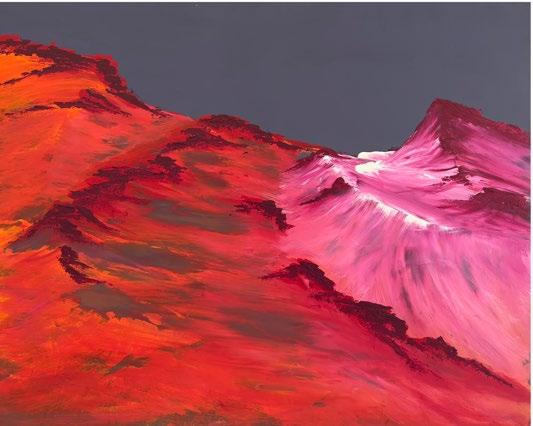

South Australian Native Title Services Level 4
345 King William Street Adelaide SA 5000
Editor Keith Thomas
Communications Officer Caleb Sweeting
Journalist Isaac Selby
Design and Printing We Create Print Deliver
Advertising Enquiries (08) 8110 2800
Circulation 10,000
If you have any stories of interest to our readers, please address any correspondence to:
aboriginalway@nativetitlesa.org
Aboriginal Way
South Australian Native Title Services Level 4
345 King William Street Adelaide SA 5000
Ph: (08) 8110 2800
Fax: (08) 8110 2811
FREECALL: 1800 010 360
The Editor has the final decision on all stories and advertising that appear in this publication.
www.nativetitlesa.org
Cover image:
WARNING: Aboriginal and Torres Strait Islander readers are warned that the following publication contains images, names, and stories of deceased persons.
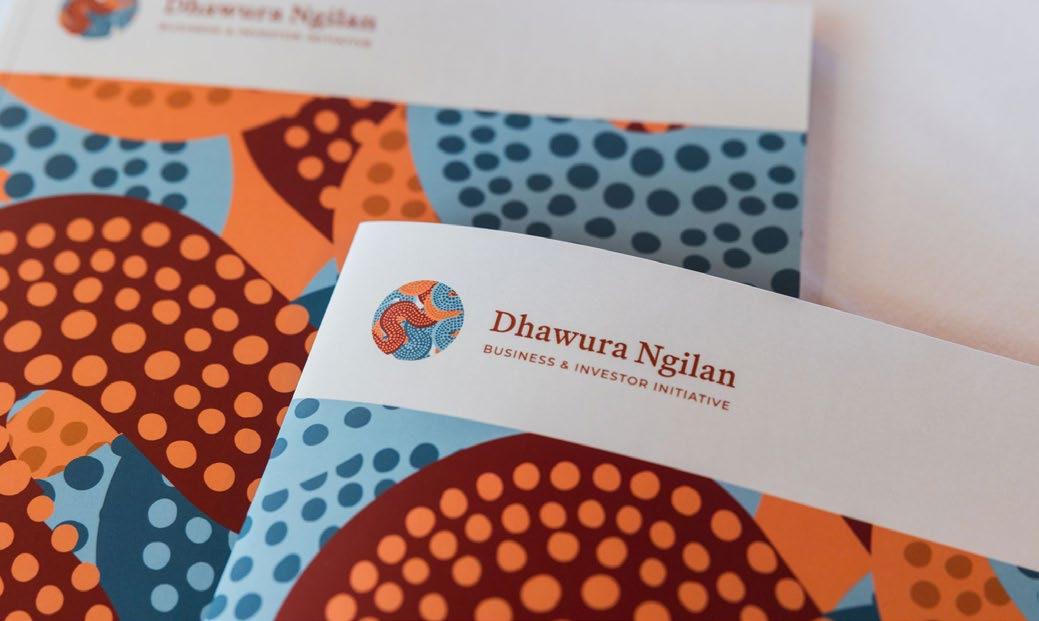
The First Nations Heritage Protection Alliance (FNPHA) is calling on businesses and investors to incorporate best practice standards into their operations.
Our current cultural heritage legislation places the decision-making with ministers and requires little to no consultation with Traditional Owners.
Instead of waiting for laws to catch-up, the private sector can refer to the Dhawura Ngilan Business and Investor Guides, which outline the steps businesses should take to uphold the UN’s principles of free, prior and informed consent.
The guides are inspired by, and take the name from, the Dhawura Ngilan Vision drafted by heritage councils across the country.
This vision sets the course for First Nations heritage, and provides advice to investors in managing the legal, financial and reputational risks associated with cultural heritage destruction.
Sadly, we continue to see the destruction of sacred sites due to weak cultural heritage laws. Most recently, the Environment Minister, Tanya Plibersek, approved the clearing of Binybara (Lee Point) to make way for defence housing – despite Larakia people sharing stories of the area’s sacred waterways, traditional camping places and ceremonial grounds.
I compel businesses to read and follow the advice outlined by Traditional Owners in the Dhawura Ngilan Vision to prevent another Juukan Gorge or Binybara. SANTS and the FNHPA won’t settle until governments give Traditional Owners the final say about their sacred land and waters.
Read the Dhawura Ngilan Business and Investor Guides: https://culturalheritage.org. au/business-investor-guides/
Keith Thomas SANTS CEO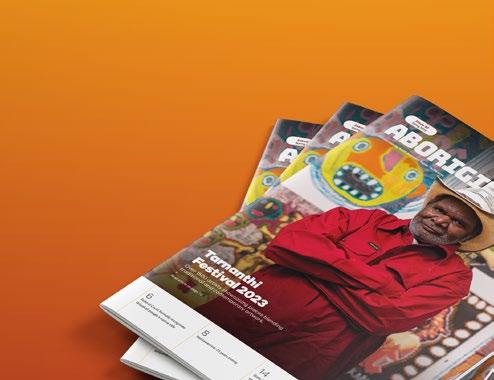

The Commissioner for Children and Young People is alarmed by their findings from an investigation into the removal of First Nations children from their families in South Australia.
Commissioner April Lawrie launched the inquiry in 2022 to find out how the Aboriginal and Torres Strait Islander Placement Principle is applied in the removal and placement of children in out-of-home care.
The Child Placement Principle aims to keep First Nations children connected to their families, communities, cultures, and Country and to ensure families are involved in decisions made about their children’s care.
Findings from the inquiry were released in a preliminary report, after the Commissioner heard from members of Aboriginal communities, state authorities, nongovernment organisations and service providers.
The report predicted that in South Australia, “without change, by 2031 there will be as many as 140 of every 1,000 Aboriginal children in state care.”
“If this predicted increase is realised, Aboriginal children will be removed in numbers close to those of the Stolen Generation, [which saw] the historical, systemic removal of Aboriginal children from their families.”
The report makes 17 early recommendations to inform the state government’s proposed reform of the Children and Young People (Safety) Act 2017, and reflects the voices of over 400 Aboriginal children, young people, families and community members and 500 sector stakeholders.
Read the preliminary report at cacyp.com.au/inquiry (the final report will be handed down later this year).
Nauo No.2 - Timetabled for determination after May 27, 2024.
Yandruwandha Yawarrawarrka 2 (claim in Queensland) – Determination authorised with a hearing scheduled for 4 July 2024.
Walka Wani Oodnadatta 1 and 2 and Arabana 2 – Special leave application to High Court by Arabana waiting to be heard.
Far West Coast (FWC) Sea claim –Judgment reserved.
First Peoples of the River Murray and Mallee No. 2 – Consent determination negotiations and subject to programming orders.
First Nations of the South East #2 and Ngarrindjeri Part B – Mediation and timetable for consent determination.
First Nations of the South East #1 –Timetabled for determination in 2024.
Malyankapa – Connection report provided to NSW and SA Governments for assessment.
WITHOUT CHANGE, BY 2031 THERE WILL BE AS MANY AS 140 OF EVERY 1,000 ABORIGINAL CHILDREN IN STATE CARE.”
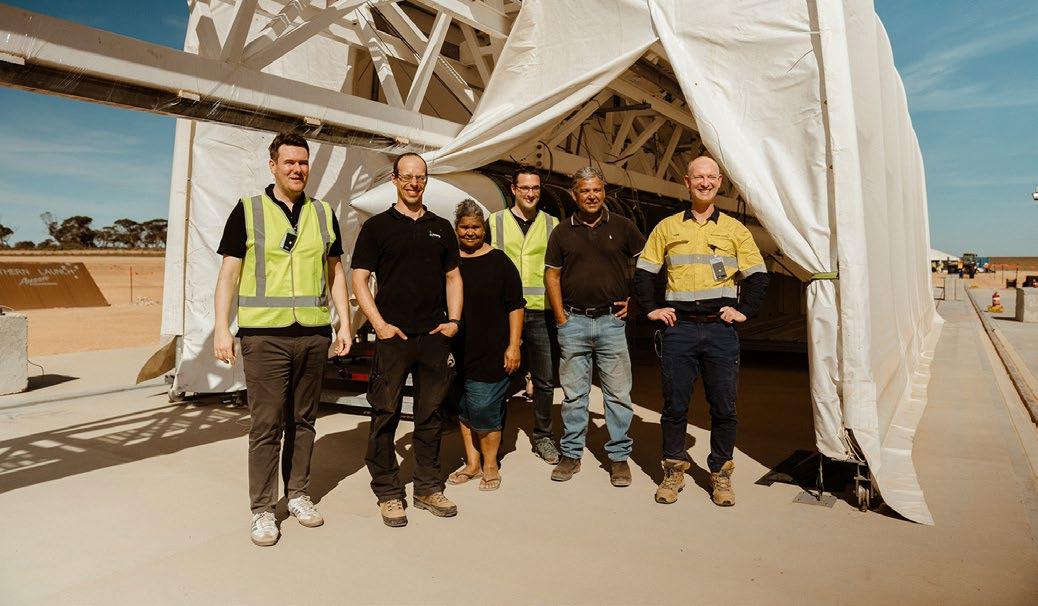
New rocket launch facilities at the Koonibba Test Range, a partnership between Southern Launch and the Koonibba Community Aboriginal Corporation, have been used to fire a test rocket for the very first time.
Located northwest of Ceduna, the facility is the largest commercial testing range in the Southern Hemisphere.
The first rocket launched successfully on May 3, reaching an altitude of 50 kilometres before parachuting back to the Earth’s surface where it was recovered for testing.
The test launch utilised hybrid propulsion technology, combining paraffin wax and liquid oxygen to create a non-explosive fuel for improved rocket handling.
Southern Launch and the Koonibba Community Aboriginal Corporation have been working since 2017 to develop the range.
Koonibba Community Aboriginal Corporation chair, Gerladine Ware, spoke to the collaborative relationship with Southern Launch as an opportunity for future and ongoing prosperity, describing it as bringing wide-ranging benefits to the Koonibba people.
community and provides an industry to support and inspire our people.
“The Koonibba Test Range brings wide-ranging benefits to our people from investment, employment through to inspiring our children and young people.”
Space tourism has been highlighted as a key focus surrounding the partnership, with an Astronomical Centre and Observatory expected to contribute $500,000 annually to the Koonibba community. These figures are based on projected interest from tourists and global space companies.
THIS IS AN EXCITING TIME FOR THE KOONIBBA COMMUNITY AND THE CEDUNA REGION AS A WHOLE. THIS WILL BE THE FIRST LAUNCH FROM OUR NEW PERMANENT FACILITIES AND WE ARE ALL EXCITED TO SEE OUR PLANNING BECOME A REALITY,” MS WARE
“Partnering with Southern Launch to develop these permanent facilities on our land secures our future as a
The Koonibba Test Range provides local and international space companies with the unique ability to launch and land on the same range facility, enabling them to recover their technologies and analyse system performance.
South Australian steel company Ferretti International and hydraulic engineers Hydroil are responsible for manufacturing a transportable rocket launcher being used for the test.
It enables sub-orbital missions to the edge of space to conduct experiments and the range is capable of supporting re-entry of space technology from orbit.
Minister for Industry, Innovation and Science, the Honourable Susan Close MP, said the partnership would facilitate a “crucial testing ground” for multiple levels of space pioneers to integrate further technological advancements.
“Having permanent facilities at the Koonibba Test Range helps bring together South Australian space companies and the Koonibba Community Aboriginal Corporation to develop a spaceport that we can be proud of,” Ms Close said.
“Through the partnership between Southern Launch and the Koonibba community, ground-breaking space exploration is set to unfold that will benefit the community for years to come.”
Southern Launch CEO, Lloyd Damp, echoed the sentiment of mutual reciprocity between the space industry and Traditional Owners.
“We are incredibly proud of our partnership with the Koonibba community to construct permanent facilities at the Koonibba Test Range that will bring wide-ranging benefits to the local community and to the Australian space industry,” Mr Damp said.
“The permanent, world-class facilities at the Koonibba Test Range will put Australia on the map as a space-faring nation.”
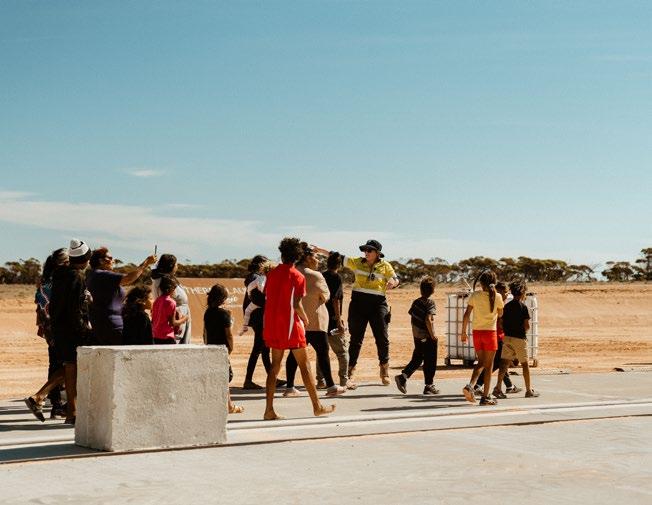
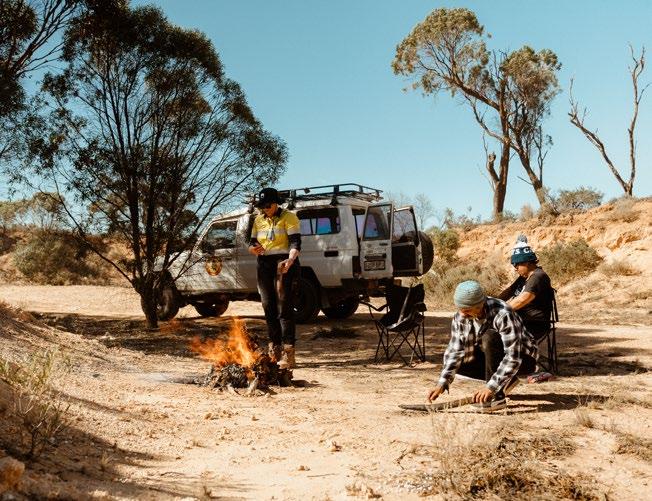

The Koonibba community came together to celebrate the new facilities at the Koonibba Test Range ahead of the inaugural launch.
Koonibba Community Aboriginal Corporation and Southern Launch hosted a community BBQ at the launchpad on April 28.
The wider Koonibba community was then shown around the launch facilities where they were able to experience the SR75 rocket up in-person.
The practice of managing Country with fire has returned to Wirraparinga (Brownhill Creek).
In April, the Firesticks team including Clem Newchurch, Paul Dixon Jr and Quahli Newchurch carried out a cultural burn in an area of Kangaroo Grass at Wirraparinga (Brownhill Creek) for the first time in hundreds of years.
Among those who attended these significant burns were involved Kaurna people, community members, students, politicians, and the Governor of South Australia, Her Excellency the Honorable Frances Adamson AC.
A throughline of continued respect and the need for increasing cultural practices on Country was delivered during speeches given by Ms Adamson, Clem Newchurch and Quahli Newchurch (Firesticks Alliance), Aunty Lynette Crocker and Ron Bellchambers (Brownhill Creek Association).
Kaurna Elder, Uncle Jeffrey Newchurch, has been involved with the area for several years, having first been engaged in efforts to stop a dam that had been proposed for the area.
He said engaging with several projects at Wirraparinga had allowed involved Kaurna members to build experience working with different community groups, organisations and government entities.
A previous celebration was held back in November 2023 for the ongoing restoration of an important Kaurna tree, named the Willawilla Karra Ku, which was acknowledged during the ceremony for the cultural burns.
“It’s about when we have an influx of community groups supporting Kaurna and walking together on this journey of saving our environment and putting a position forward,” Uncle Jeffrey said.
“It’s allowed us to build our character and gain our confidence canvasing for Kaurna because it’s always been a hard journey doing it alone.
“We had Aboriginal students here taking ownership for their backyard – it’s a powerful and engrossing thing where they do feel ownership and feel important in it.”
Cultural burns are often referred to as “cool fires” – low temperature burns usually lit at knee-height, which help germinate seeds in the soil.
Ngarrindjeri and Kaurna man, Paul Dixon Jr, was part of the Firesticks Alliance team at Brownhill Creek and hopes continued burns can change the perceptions people have of fire and fire management in general.
“We’ve been down here on-and-off for the past year, finding spots to put fire onto the Country, which is something that hasn’t been here for hundreds of years,” Mr Dixon Jr said.
“These are native plants that evolved with fire, so it’ll also kill off the invasive species that aren’t used to it.


A LOT OF PEOPLE ARE AFRAID OF FIRE, BUT I THINK EVENTS LIKE TODAY CAN CHANGE PEOPLE’S PERCEPTION ON WHAT FIRE IS AND HOW IT CAN BE USED TO LOOK AFTER COUNTRY.”
It’s all about Country telling us when it’s the right time for fire.”
Mr Dixon emphasised how careful consideration is given to all weather conditions before cultural burns to maximise the effectiveness of fire management and adherence of safety protocols.
“Today the conditions were a bit too dry; we were hoping for a bit of rain in the lead up but there was too much sunshine over the weekend, so we take this on board and leave it,” he said.


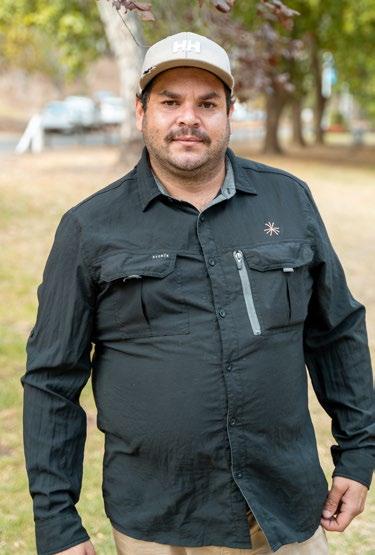
Brownhill Creek Association Community Engagement Officer and Project Manager, Ron Bellchambers, has been instrumental in leading the conservation and management of Brownhill Creek.
“Back in 2018, Willa Willa Karra Ku, the shelter tree was dying and came under development threat. We had an arborist report and consulted with other Kaurna Elders to find funding for the project,” Mr Bellchambers said.
“It’s more than seeing it as just one localised project, it’s a matter of bringing all government agencies together. Agencies like Green Adelaide, National Parks and Wildlife Services SA, while also looking at the cultural assets around it.”
Are you passionate about making a positive difference in the lives of children and young people?
Would you like to be paid to receive a formal qualification and on-the-job training?
The Department for Child Protection is committed to increasing Aboriginal and Torres Strait Islander participation in our workforce. As a Child & Youth Worker, you will ensure children and young people in our care have opportunities to experience education, connection, community, spiritual identity, and participate in social, sporting and cultural activities.
You will be part of a team contributing to:
• improving the social and living skills of children and young people in residential care
• assisting in the reunification/reconnection with their families, family-based care providers, or finding other suitable care options.
In return, you will:
• receive a competitive salary ($66,590 – $70,968 p.a.) plus superannuation and shift penalties
• accrue up to 5 weeks of annual leave
• be paid to complete a national Certificate IV qualification
• join our State Wide Aboriginal Training (SWAT)
• receive ongoing learning and development.
For more information about the role or to apply online, visit iworkfor.sa.gov.au and search for reference number 529423.
Enquiries: DCPRecruitment@sa.gov.au
For the purpose of this advertisement, the term Aboriginal is used to refer to Aboriginal and Torres Strait Islander people within South Australia. This is not intended to exclude Torres Strait Islander people, or people that identify as being of both Aboriginal and Torres Strait Islander descent.




The 40th anniversary of the historic Anangu Pitjantjatjara Yankunytjatjara (APY) Land Rights Act has been acknowledged during the long-awaited Kulilaya Festival in Umuwa.
Since putting ink to paper on the self-determining APY Lands Act in 1981, Anangu have held freehold title ownership of their Country, returning the right of selfgovernance and allowing Traditional Owners to determine how their land is managed.
The Act was one of the first to be granted in Australia and remains a unique example of freehold title negotiated between Traditional Owners and the SA government.
Kulilaya Festival 2024 took place on March 24, after facing delays due to the outbreak of COVID, and saw musicians, visual artists and performers present their history and stories through song and dance to commemorate the occasion.
Strong performances from local music groups and ensembles featured, with the likes of DEM MOB, Iwantja Band, Desert Rain, Docker River Band, Pukatja Band, Rollands Band and Amata Band singing to a receptive audience. In between sets, MC Melissa Thompson provided context to the significance of acknowledging the landmark land rights win of 1981 while pushing for renewed recognition of community voices moving forward.

THE NAME OF THE FESTIVAL KULILAYA, ESSENTIALLY MEANS LISTEN AND UNDERSTAND THIS TRUTH. THERE’S A SONG THAT GOES WITH IT THAT THIS LAND IS OURS AND HAS ALWAYS BEEN OURS.”



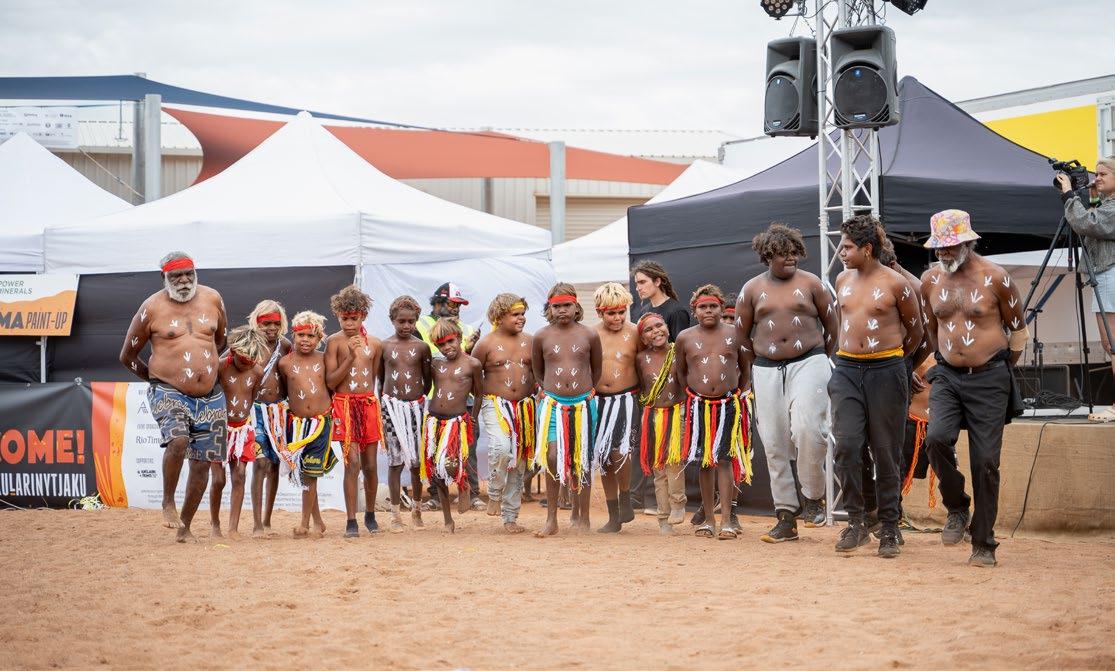
Outgoing APY Lands General Manager, Richard King, noted the festival as a time for reflection on past achievement and what still needs to be achieved moving forward.
“We’re really celebrating the fifth decade now. Anangu always knew the land was theirs and there was never really an argument about that until they realised it belonged to the Crown,” Mr King said.
“Anangu thought that’s crazy, how do we get our land back? We had about four stations here at the time and working with government and demonstrating and mobilising their community to express their rights and ownership over the land.
“It’s a positive event, it’s also an event to remember all of our Elders that have worked towards getting the land in the first place. A lot of smiles but some sadness as well when we look back at photos.”
SA Minister for Aboriginal Affairs, Kyam Maher MLC, was impressed by breakout stars DEM MOB, who performed at the festival and are the first rappers to perform in Pitjantjatjara.
“It’s an amazing thing to hear hip hop in this setting in the Pitjantjatjara, Yankunytjatjara language. People from other parts of the world are in awe that we have the oldest living culture,

tens of thousands of years of history of education and science,” Mr Maher said.
“The genesis of the APY Land Rights Act was the Dunstan government, where there was a parliamentary committee examining in great detail how a freehold land rights system might work.
“Then the Dunstan government was defeated, and it almost didn’t happen. It took demonstrations; Anangu coming down to Adelaide singing and walking, demonstrating on the the streets of Adelaide.”
During this time hundreds of Anangu travelled to Adelaide to camp out and protest the potential repeal of the planned Act.
Mr Maher said he was hopeful that recent SA Voice to Parliament nominations would see strong representative voices given to residents of the Central Desert region.
SA Greens Senator, Tammy Franks, is no stranger to the Lands, having spent 12 of her 14 years in parliament on the Aboriginal Lands Parliamentary Standing Committee.
Speaking in attendance at Kulilaya she emphasised the importance of the educational and structural upkeep of the Lands.
“I’d like to see respect for the Aboriginal lands, the rights we have fought hard for over decades renewed and understood by politicians as they come through Parliament House in Adelaide,” Ms Franks said.
“I’d like to see the basics, which aren’t necessarily the exciting things, but they’re the essential things. We should never see people left without power, water, food security, housing. We’ve just got to keep chipping away and making progress.
“It’s been great to see better connection, better power, better resourcing. There’s still a lot to do but it is vastly improved each time I come here. The art centres of course are such a joy and such a success not just in other parts of Australia but across the globe.”
A large circular dancing pit was custom-built for Kulilaya Festival, with APY Head of Maintenance, Daniel Omenzetter, part of a wider team responsible for relocating sand from the nearby riverbed for the event.
“It was roughly 200 tonne of river sand that we’ve had to dig out. It was three days work to get that all sorted and raked out and create the circle that’s here now,” Mr Omenzetter said.
“We started talking about this three or four years ago, so it’s great to finally have the festival today. Everything that’s been organised is a big team effort. We hope it’s going to be a big hit and talked about for years to come.

Health celebrate positive outcomes on the Lands
Ngarrindjeri man, Damien Shen, is the Director of Aboriginal Public Health. His role includes collaborating with APY officials to provide accessible services to several of the area’s many remote communities.
“The thing that Anangu appreciate is when it’s a two-way conversation, where we’re not just coming here telling people what to do,” Mr Shen said.
“If we look at how we holistically work, we learned a lot from the COVID response during the pandemic and looking at how we work with the communities.
APY HAVE ALWAYS BEEN VERY GOOD AT MAKING SURE THEIR VOICE IS HEARD BUT WHAT THIS WILL DO IS GIVE VOICE TO AN AREA EVEN BIGGER THAN THE APY LANDS,” MR MAHER

“We’ve gone away and created videos that have been translated into Pitjantjatjara, it’s about being more patient and giving time and space.
Nothing beats face to face in these communities.” Mr Shen said many of positive outcomes on the Lands during the past 12 months had come through working with their tuberculosis response team.
Since 1994, Ara Irititja, run by John and Dora Dalwitz, has provided extensive archival services for Anangu people across the APY Lands.
Footage filmed during the 25th anniversary event celebrations was showcased alongside historical images during the festival.
Mr Dalwitz paid respect to the senior Anangu who had passed since the previous anniversary, with only a handful of Elders left who were involved with the initial passing of the APY Land Rights Act.
“Two of the main speakers are still here with us, Owen Burton and Donald Fraser. One of the most significant people involved was Punch Thompson… the young man who negotiated with the premier in 1981 and was one of the people chosen by Anangu to actually receive the title - which he did,” Mr Dalwitz said.
“Even at that time [the 15 th anniversary] some Anangu were saying ‘we’re a bit
disappointed it hasn’t gone quite the way we want’,” Mr Dalwitz said.
“They were saying ‘we feel really proud that we’ve got control of our Country like we wanted to’ but perhaps felt there was still too much government interference.”
Punch Thompson’s daughter Melissa acted as MC during Kulilaya Festival.
Alongside exhibiting previous archival footage during the event, the Dalwitz’s emphasised and were hopeful for increased archival activity amongst not only the Anangu, but all First Nations groups across the country.
“APY are going to make sure we get all of the footage and the movies and data to put in the archive. That kind of archival thinking is really important and I think that more and more it’s taking hold in these kinds of organisations,” Ms Dalwitz said.
Full audio interviews recorded at Kulilaya are available via the Aboriginal Way podcast on Spotify.
In April, the media team at SA Native Title Services recorded Yandruwandha and Yawarrawarrka Elders sharing stories about their Country around Innamincka.




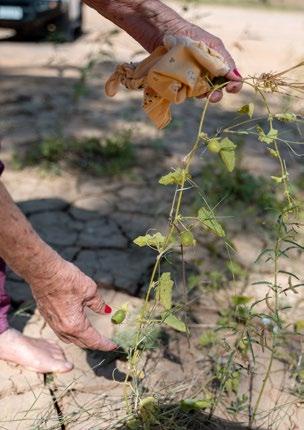
Elders Shirley Harris, Gloria Paterson, Lynette Naylor, Joyce Singleton and Julie Bird live away from their traditional lands, but still hold a strong connection to the area.
While fishing along the Cooper Creek (Kinipapa) with a handline, Aunty Gloria, in her 80s said; “Every Australian should be told about the food that’s in this country, because it’s like walking into Woolworths. I know I would not starve between here and the great distance over there, because from the water to the gumtrees there is food – it’s like three different sections of one shop.”
Aunty Gloria and her sister Aunty Shirley said their mother and grandmother taught them how to find bush tucker in and around Cooper Creek. They caught plenty of fish and found pudhukani (native melons) during our conversation.
The sisters explained how Aboriginal people go walkabout, not because they are aimless, but because different parts of the Country are fruitful at different times of the year. They say if we come back in four weeks the young pudhukani will be ripe and ready for eating.
Aunty Lynette Naylor was emotional about being back on Country and said her heart and soul will “always be connected to Innamincka”
even if money and distance prevent her from visiting more often.
“You know what brings us back, is what we can afford and it’s the most important thing in the world. We might live in different parts of Australia, but we are Aboriginal people connected to our homelands,” she said.
The trip coincided with the second running of a light show created by Yandruwandha Yawarrawarrka Traditional Land Owners Aboriginal Corporation. Padla Ngalungga Kinipapa was projected onto the AIM Building at Innamincka and depicted traditional stories of Yandruwandha and Yawarrawarrka people and their interactions with the infamous explorers Burke, Wills, and King.
WHEN WHITE MAN FIRST CAME HERE THEY WOULD STAY IN ONE PLACE UNTIL EVERYTHING WAS JUST ABOUT BARE, WHEREAS BLACKFELLAS NEVER DID THAT; THEY’D STAY THERE FOR A WHILE AND THEN THEY’D MOVE ON, SO THAT GIVES THAT LAND A BREAK,” AUNTY SHIRLEY.
In late 2023, Reconciliation SA launched our new Strategic Direction plan for 2024 to 2026.
We are also pleased to announce the recent release of a vital new anti-racism resource for schools and pre-schools.
Education, action, and change: an anti-racism resource will assist preschools, primary and secondary schools in teaching and learning about racism and its impacts.
Divided into three parts, the anti-racism resource provides a blueprint for teachers and educators to understand and address racism.
Part one, education, outlines racism and its impacts.
Part two, action, addresses the actions someone can take to combat racism and have necessary conversations.
Part three, change, provides suggestions for changes teachers and educators can make to dismantle racism in education and outlines strategies for all levels of education.
To download a free copy of the document, you can visit our website, www. reconciliationsa.org.au and find it under the heading, Training & Services.
Wiradjuri and Ngunnawal actor, Luke Carroll, a passionate advocate of antiracism, has come onboard to become an ambassador to the resource, saying, “I’m proud to be the ambassador for the Education, Action and Change: An antiracism resource. In a world where diversity should be celebrated, it is essential that we cultivate anti-racism values in our children and our young people, they are the future leaders, the changemakers and the influencers that will shape our society in the future.”
The resource was launched at the National Wine Centre on Kaurna Country, featuring a Welcome to Country from Jack Buckskin, and photography by Adam Jenkins from Deadly Designs Media.
Also in development is a new anti-racism workshop from our anti-racism consultant, Shaun Childs.
The presentation comes in two parts: a three hour and two hour presentation, given two weeks apart that will assist businesses and organisations in coming to terms with the reality of racism and give them the tools to begin their anti-racism journey.

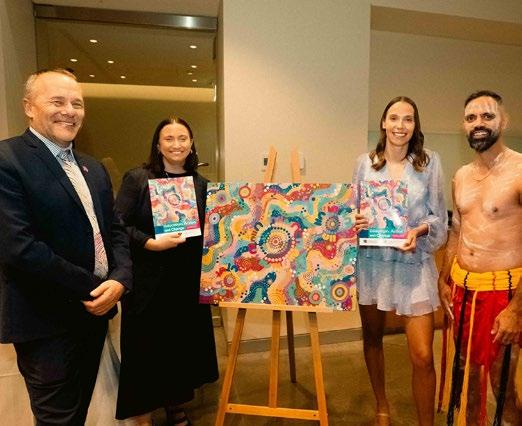
While still in development, the early feedback from pilot sessions has been positive, and we look forward to officially launching the program in the future.
We are also looking forward to our National Reconciliation Week Breakfast, which, after nearly doubling in size, sold out after announcing rapper Adam Briggs as our keynote speaker, alongside a number of other fantastic entertainers such as DEM MOB, Rob Edwards, and Of Desert & Sea Dance Group.
Don’t forget to check out our revamped website, along with our new membership platform that will help bring Reconciliation SA into the future.
For more information on memberships and what’s included download our memberships guide via reconciliationsa. org.au/become-a-member.


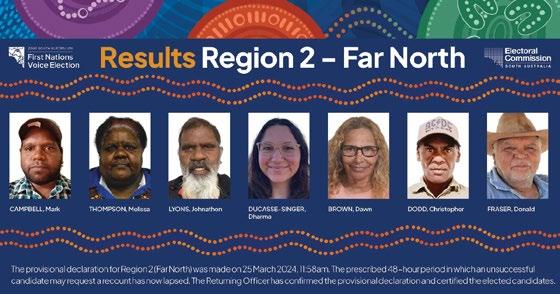

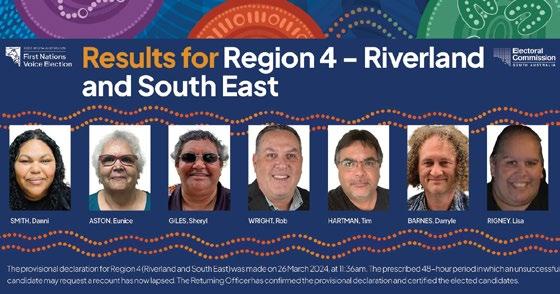



Key members of Narungga Nation, Department of Infrastructure and Transport (DIT) and global commodities exporter T-Ports have been working together to sure up mutually beneficial practices at Wallaroo.
New shipping infrastructure on the foreshore has been receiving cultural consultation from involved Narungga peoples, with the opportunity for naming the newly established port being offered to the group.
T-Ports have built a causeway that goes approximately 200 metres out to sea, a unique operation designed for use with a transhipment vessel, a barge that will come between a much larger ship that sits out in the ocean.
DIT Executive Director of People and Corporate Services, Graham Jackson, said the opportunity to name a port is relatively rare with most existing ports already named.
Mr Jackson emphasised the direction of having it named by Narungga as a key goal of the collaborative project.
“This project gives us a unique opportunity to name a port and harbour where we haven’t had that opportunity for quite some time,” Mr Jackson said.
“We’re very keen in the department to engage with
Narungga to come up with an Aboriginal name for the harbour if we can.
“We really want to be led by the Narungga people in relation to how they would like this to go, it’s not for us to lead - it’s for them to tell us what they would like.”
Narungga Elder and Wallaroo resident, Peter Turner, presented a cultural tour for T-Ports workers, DIT employees and fellow attendees, on-site at the newly minted port.
“Native title has got it’s positive and its negativesthe positives are that we’re negotiating and having more face-to-face meetings and conversations with different government departments,” Mr Turner said.
“I’m very happy that we now get brought to the table and can express our views on issues of caring for Country and the environment and all aspects of our Country.”
The Wallaroo T-Port site is located along beachfront containing vast quantities of chert, a hard sedimentary rock used by Narungga peoples for a wide range of activities including tool creation, hunting and the preparation of animal hides.
Included in an Indigenous Land Use Agreement (ILUA) signed by Narungga and T-Ports is a condition that these reserves of chert remain undisturbed in order to preserve their cultural significance.

T-Ports CEO, Nathan Kent said the engagement has been a “huge learning curve” for the company, which was established in 2018, flagging the ability to draw on thousands of years of history as a key process of education.
“What was educated to me early on was the opportunity for the Narungga people to come start this conversation and naming this port for us which we thought was a fantastic initiative,” Mr Kent said.
“It’s just a huge learning curve for us, we’re a young company and today’s journey and the learning and stories we heard about the history has been a fantastic education.
Mr Kent flagged future employment opportunities as one of the strongest outcomes of conversation had during the port consultation.
“Wouldn’t it be a great story if we had some of our ship masters who actually were Narungga people as well, that would be a great story to have.”
CEO of Narungga Nation, Doug Milera, said that without in-person engagement it can sometimes be an arduous task to get people to talk about these sorts of opportunities.

“Today we’ve talked about how we can get Narungga people employed with T-Ports. Whether it be on land or on the sea so we’re going to talk further about what those opportunities might be and how we can present those to our community,” Mr Milera said.
DUE TO RECONCILIATION ACTION PLANS AND THE NATIVE TITLE ACT WE’RE HAVING MORE AND MORE NEGOTIATIONS WHERE OUR NEEDS AND WANTS ARE BEING ADDRESSED.”
“It’s always best to talk face-to-face so people can be more at ease, open and honest in their discussions. It takes away a lot of that bureaucratic nonsence you get from emails and phone calls that can hamper progress.”
“With T-Ports we’ve been fortunate enough that they’ve been upfront and transparent in their discussions with us about how they can help us, so we want to take on board those discussions and look at some of the positive outcomes that can come from it all.”
